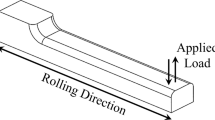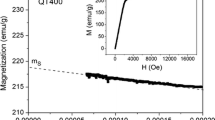Abstract
The critical cooling rate to achieve fully martensitic structures was determined for rimmed and aluminum-killed SAE 1010 steel containing various amounts of carbon and nitrogen. Fine grained aluminum-killed steels required a cooling rate approximately two times higher that rimmed steel for all carbon andnitrogen contents evaluated. Alloying may be required to reduce the critical cooling rate to a rate achievable in oil-quenched carbonitrided components processed from aluminum-killed steel.
Similar content being viewed by others
References
D. L. McBride, C. H. Hertz, Jr., and R. F. Mehl: ASM Trans., 1936, vol. 24, p. 281.
M. A. Grossman: Elements of Hardenability, p. 54, American Society for Metals, Cleveland, Ohio, 1952.
M. M. Shea and E. R. Mantel: General Motors Research Warren, Ml, unpublished research, 1983.
G. Rengstorff, M. B. Bever, and C. F. Floe: ASM Trans., 1950, vol. 41, p. 100.
“Cooling Transformation Diagrams”: Metal Progress Data Sheets, Metals Progress, 1974, vol. 106, p. 175.
Author information
Authors and Affiliations
Rights and permissions
About this article
Cite this article
Mantel, E.R., Shea, M.M. Hardening response of carbonitrided rimmed and aluminum-killed SAE 1010 steels. J. Heat Treating 4, 237–246 (1986). https://doi.org/10.1007/BF02833301
Issue Date:
DOI: https://doi.org/10.1007/BF02833301




